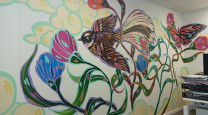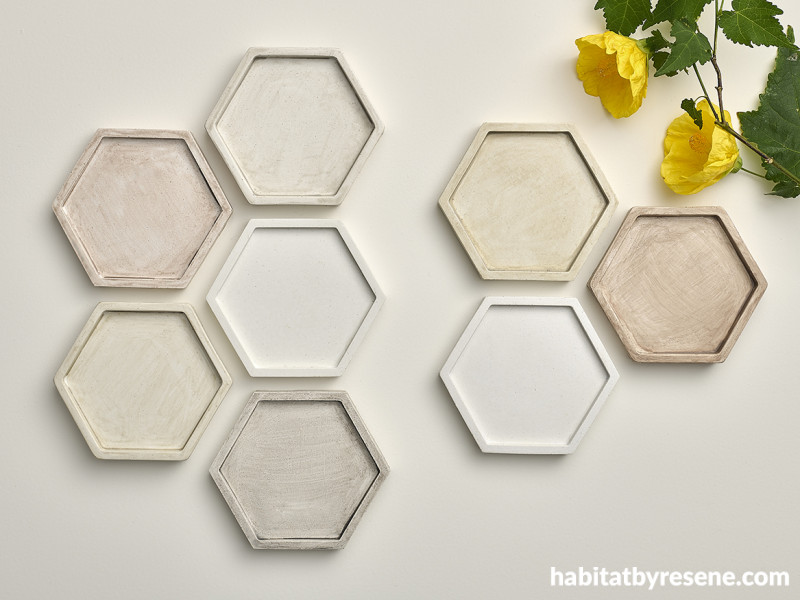
Where and why you should be using Resene colour washes to transform your project materials
10 Jul 2023
One of the most significant impacts that the Covid-19 pandemic has had on the architecture, building, interior design and property management industries is reducing material availability. Where we used to be able to better rely on lead times for even the most specialty products, many have found it difficult to secure even the most basic building materials in a timely manner. When your project needs to stick to a strict timeline, this can sometimes mean that you and your client have to settle for finishes that might not have been your first choice – for example, having to opt for basic pavers instead of the special-order ones that would have been the perfect colour to coordinate with the rest of your Resene colour palette.
If this scenario sounds all too familiar, we have some great news. While applying an opaque coat of Resene paint is always an effective option for changing the look of various surfaces on your project, recently, there have been some exciting developments in Resene’s coatings technologies. These innovative new Resene products mean that you and your clients have more options than ever before for getting a highly-desirable colour washed look on a wide range of materials. With these softer, semi-transparent formulas, it’s never been easier to create a uniquely customisable look that looks anything but off-the-shelf.
We look at why and where you can incorporate Resene colour washes in your next project, plus our top tips for specifying and applying them.
Colour washes offer a different option for changing the look of your project’s materials.
Even the most seasoned architects and designers know that it is not unusual for some components of your project to turn out a different colour than expected once seen in situ. One common struggle is when the timber you’ve ordered arrives with an inherent tone that’s far more yellow that you’d hoped it would be to suit the colour temperature of the rest of your palette.
Resene Colorwood and Resene Woodsman colour washes offer a unique opportunity for changing the look of your project’s interior and exterior timber in a way that clear finishes and conventional wood stains can’t. Because the inherent hue of most timbers tends to be on the warmer side, Resene’s timber colour washes can be used to impart a cool, neutral or warm finish that could be a better fit to sit within your chosen colour scheme. And since the wood grain remains visible with Resene colour washes, your design still benefits from the natural appeal of the timber but in a colour that better fits your palette.
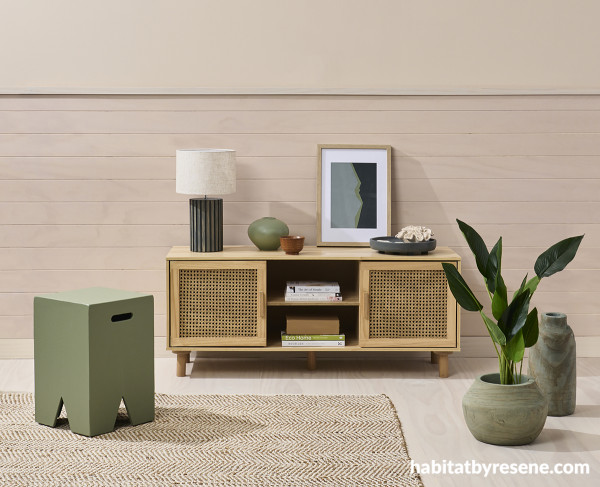
Look to the Resene Colorwood We Speak Beach palette for a range of contemporary colour wash hues that can be used on interior timber surfaces such as wood-clad walls, floors, ceilings and more. Wall in Resene Bone with tongue-and-groove panelling finished in Resene Colorwood Becalm, floor in Resene Colorwood Breathe Easy, sideboard in Resene Colorwood Bask, lamp and low platter in Resene Colorwood Shade, wooden plant pot and vase (on floor) in Resene Colorwood Shore Thing (left) and Resene Rising Tide (right), stool and painted vase (on sideboard) in Resene Paddock, faux coral in Resene Bone, painted book in Resene Brown Sugar and DIY artwork in Resene Rolling Stone, Resene Paddock and Resene Mine Shaft.
Concrete is another product that can have hugely variable results. With the right plan, preparations and product sourcing in place, there’s no limit to the types of colours and shapes that can be created with concrete. During the short window of time when it is wet, it can be manipulated, textured, made smooth or pigmented. But once that window closes, the material suddenly becomes notoriously inflexible to further edits.
When your concrete comes out a different colour than you were expecting, there is a new option available to change its look: the Resene ‘In The Wash’ collection of concretewash colours. This new range can be used to bring subtle, buildable sheer colour to concrete walls (interior and exterior), interior floors, exterior walkways and decorative elements like concrete planters and furniture. The product leverages Resene Concrete Clear, Resene Concrete Wax and Resene Concrete Clear Walk-on technology to offer customers a variety of different finishes to both colour and protect set concrete. Five colours are currently available – Resene Whitewash, Resene Greigewash, Resene Blondewash, Resene Claywash and Resene Stonewash – to impart a range of different nature-inspired hues.
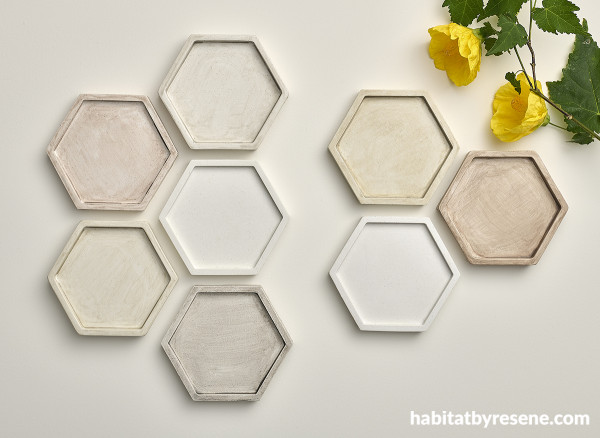
Resene has a range of colour options for changing the look of concrete and brick. Look to the Resene In The Wash palette for the latest colour offerings, and learn more about where and how to use it in issue 06 of BlackWhite magazine. Background painted in Resene Rice Cake with concrete hexagon plates in (clockwise from top left) Resene Concrete Clear satin tinted to Resene Greigewash, Resene Whitewash, Resene Stonewash, Resene Blondewash and Resene Claywash. White concrete plates from Blow My Wick.
Colour washes can be used on a wide range of surfaces, both inside and out.
When it comes to where Resene colour washes can be applied, you’ll find that there aren’t many limitations. Whether your substrate is timber, concrete, brick, cork, gypsum or steel, there are ways to create a colour washed effect with the right Resene products and application method. Since most Resene colour wash products are protected with a clear topcoat, anything from walls, floors, ceilings, benchtops, doors, trims, planters, decking, décor accessories, artwork and sculptures can become your colour washing canvas.
Depending on the products and colours you and your client decide on, your Resene colour wash finish can look anywhere from modern and contemporary to aged and rustic. In projects that feel a bit too sterile, they’re particularly effective for imparting a naturally inviting, lived-in vibe thanks to their softened effect.
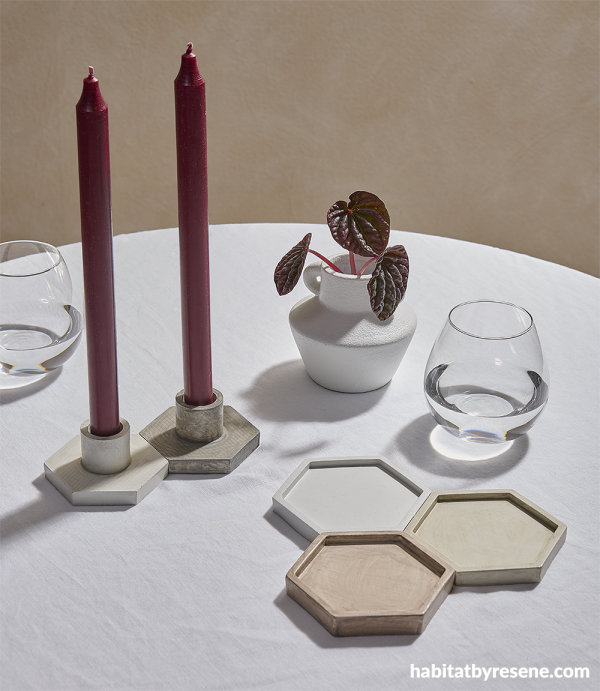
Concrete candleholders in Resene Concrete Clear satin tinted to Resene Stonewash (left) and Greigewash (right), concrete hexagon dishes in (clockwise from top left) Resene Concrete Clear tinted to Resene Whitewash, Resene Blondewash and Resene Claywash and vase painted in Resene Eighth Thorndon Cream. Concrete objects from Blow My Wick and taper candles from Tessuti.
Colour washes offer buildable and customisable colour.
Another thing that really sets Resene colour washes apart from opaque options is how many different looks you can achieve with just a single product. Since these products are semi-transparent by nature, having the ability to build up layers of colour means you’re in total control of your finished effect as you have the option of creating a subtler or more pronounced effect depending on the number of coats you choose to apply.
By switching up your application methods, Resene colour wash products can offer even more ways to customise your look. For example, spray application of Resene ConcreteWash can achieve a uniform wash of colour. But if a more mottled, fresco-like look is desired, the same product can be applied by brush in a criss-cross motion.
For those really open to experimentation, you can even try layering different two or more different colour wash colours on the same surface – test out your proposed combinations first on an offcut of your same substrate before solidifying your specification to ensure you’re happy with the final effect.
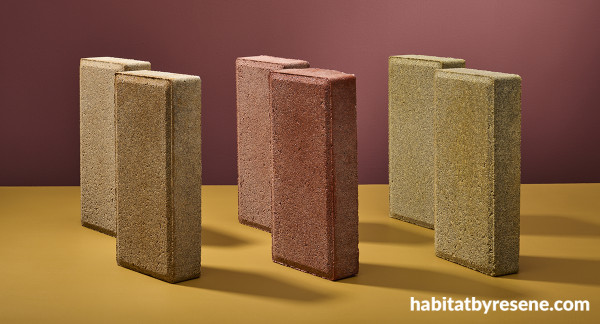
Originally white, these paving bricks have been transformed with Resene Concrete Stain. The pairs, from left to right, have been stained in Resene Autumn Leaves, Resene Red Terracotta and Resene Sandy. The back three bricks have two coats of product applied – which is the standard recommended number of coats – whereas the front three bricks have three coats of product applied, giving them a slightly darker appearance. Resene Concrete Stain is also available in four additional neutral hues: Resene Bleached Sand, Resene Bleached Grey, Resene Deep Grey and Resene Black. Background painted in Resene Savour and Resene Salted Caramel.
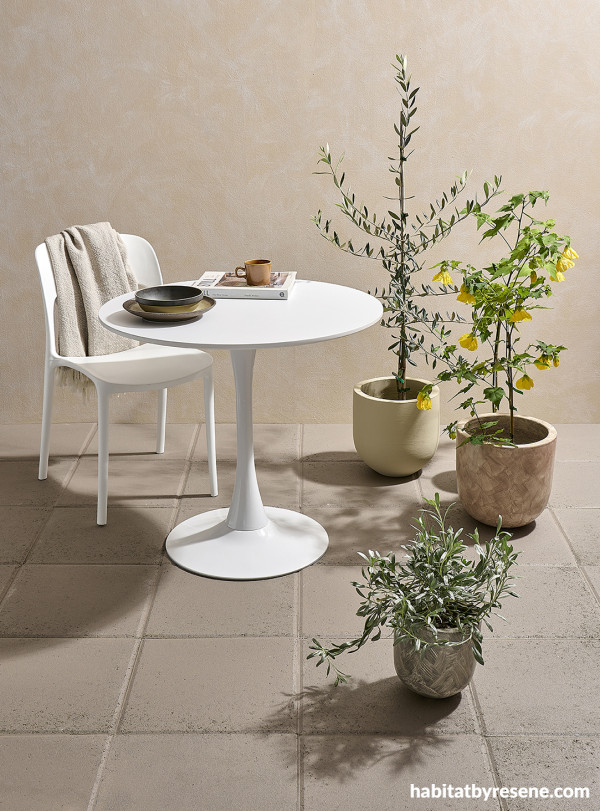
The beauty of Resene In The Wash concretewash colours lie in their subtleness, with buildable colour that can be used to create a variety of looks. Applying the product by spray can achieve a uniform wash of colour over walls or floors, but you can also get an artisanal, almost fresco-like effect with a bit of experimentation – like on the front two plant pots. For example, try applying Resene In The Wash concretewash colours with a brush in a criss-cross fashion to concrete planters or accessories for a variegated look.Wall painted in Resene Sour Dough with Resene FX Paint Effects Medium mixed with Resene Blanc applied on top, floor in Resene Walk-on Concrete Clear tinted to Resene Claywash and plant pots in (from front to back) Resene Concrete Clear satin tinted to Resene Stonewash, Resene Concrete Clear satin tinted to Resene Claywash and Resene Double Akaroa. Chair from Danske Møbler, plant pots from Mood.
Colour washes help protect timber substrates from harmful UV rays.
Incorporating timber into your project is an investment, and it’s something that both you and your client are going to want to safeguard from damage. Many want their project’s timber surfaces to take on a ‘natural’ look, but even though indoor timber which is partially sheltered from direct sunlight, a clear finish alone may not be enough to protect it from damage like fading and discolouration inflicted by UV exposure. This can cause the timber to clash with the other natural materials and colours you’ve decorated with – and put your client’s investment at risk.
Resene Colorwood Whitewash, Resene Colorwood Light Greywash and Resene Colorwood Mid Greywash are excellent choices for bringing a softer, natural look to interior timber. These long-standing favourites allow the beauty of the timber grain to show through while imparting a touch of colour with a weathered finish, softening those harsher inherent tones and providing additional protection from UV light. It’s a waterborne formula which can be built up by adding additional layers in circumstances where less transparency and more pigment is ideal. And if clients later decide they want a different look, Resene Colorwood washes can be stripped back and recoated with a new favourite or painted over.
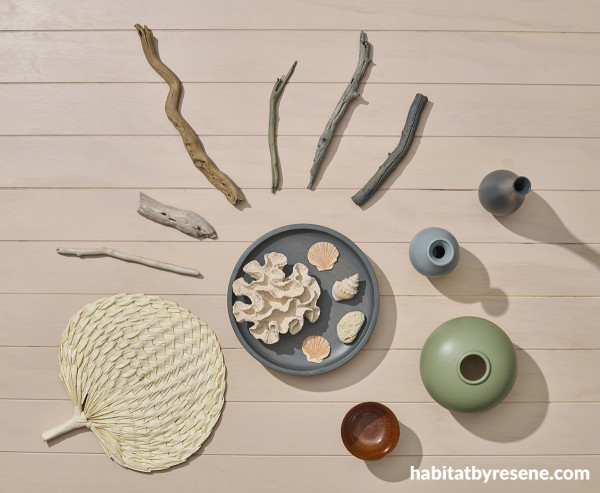
You can specify Resene Colorwood washes on canework, cork, doors, dressed and rough sawn timber, fibre and particle board, furniture, kitset and nursery furniture, plywood panelling, timber (imported and native), timber ceilings and beams, flooring, window and door frames. Background finished in Resene Colorwood Becalm with driftwood in (clockwise from left) Resene Colorwood Breathe Easy, Resene Colorwood Becalm, Resene Colorwood Bask, Resene Colorwood Shore Thing, Resene Colorwood Rising Tide and Resene Colorwood Shade, platter in Resene Colorwood Shade, faux coral in Resene Bone and painted vases in (from top to bottom) Resene Rolling Stone, Resene Mine Shaft and Resene Paddock.
Colour washed looks can even be achieved on painted surfaces.
To get a colour washed look on painted surfaces, you can leverage Resene FX Paint Effects Medium – which allows you to layer two or more Resene paint colours and can be used to impart a limewashed, fresco or ‘aged concrete’ effect.
When specifying colours for surfaces that you will be using Resene FX Paint Effects Medium on, be cognisant that the order in which your Resene colours are applied will affect your final look. Resene FX Paint Effects Medium works like a glaze, in that it makes the colour you mix it with sheerer – allowing some of the colour below to show through. Applying a darker colour over a lighter colour will result in a lighter look while a lighter colour applied over a darker colour will generally appear darker overall. Before locking in your specification, it’s recommended to make a test panel of your paint effect to check that you’re happy with the look of your proposed combination or colour and they order they’re applied. This can be compared with the rest of your finishes on your sample board and then supplied to the applicator as a reference once it’s time to paint.
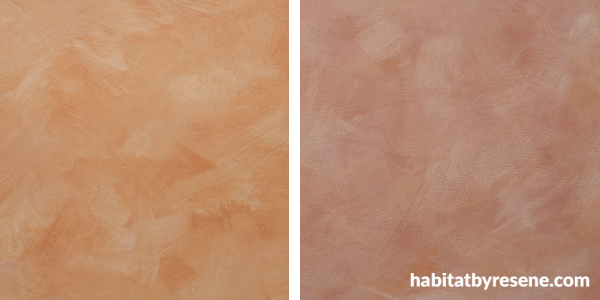
To demonstrate what a difference the order your colours are layered can make on your finished paint effect, these two paint effects were created by the same applicator using the same Resene colours and products but in a different order. On the left, two basecoats of Resene SpaceCote Low Sheen tinted to Resene Alpaca were applied first followed by Resene FX Paint Effects Medium coloured with Resene Sante Fe. On the right, the applicator started with two basecoats of Resene SpaceCote Low Sheen tinted to Resene Sante Fe and then applied Resene FX Paint Effects Medium coloured with Resene Alpaca.
Find more ideas for using Resene colour washes in issue 04 and issue 06 of BlackWhite magazine. To learn about the right formulas to specify for your particular project, get in touch with your Resene representative or your local Resene ColorShop.
projects Amber Armitage, Laura Lynn Johnston
images Bryce Carleton, Wendy Fenwick
Published: 10 Jul 2023
